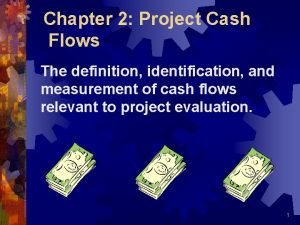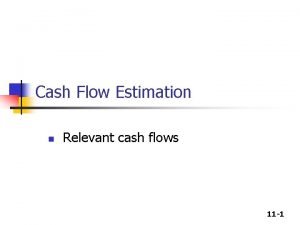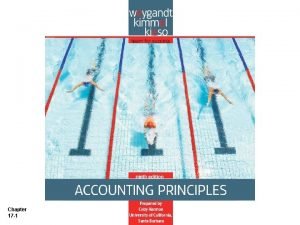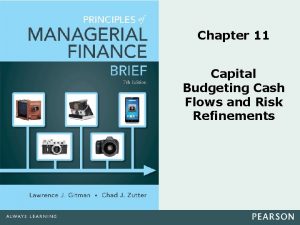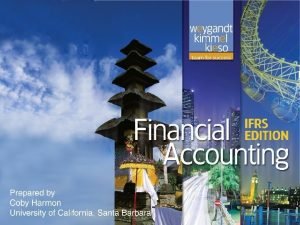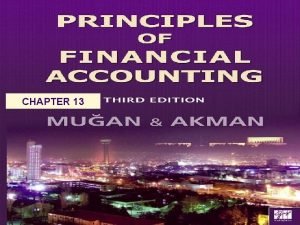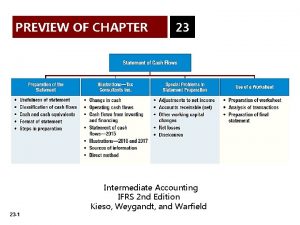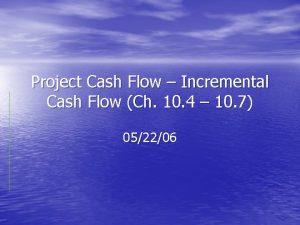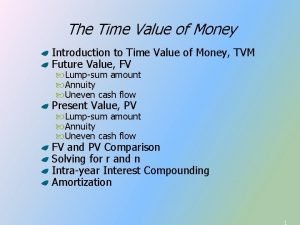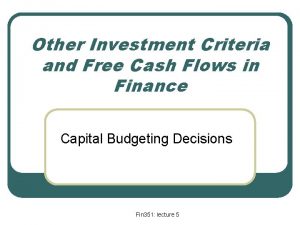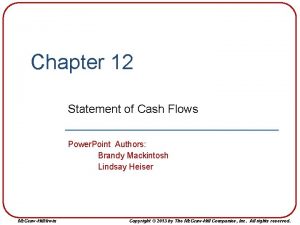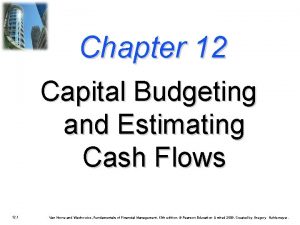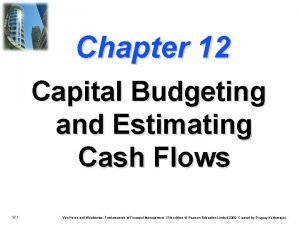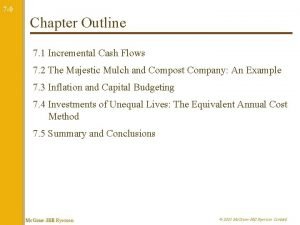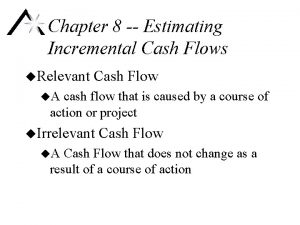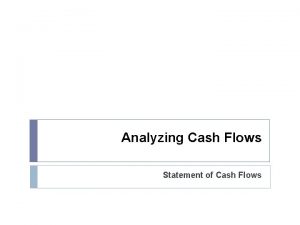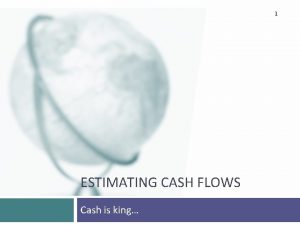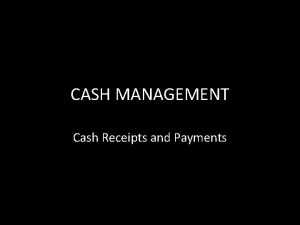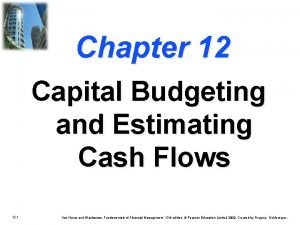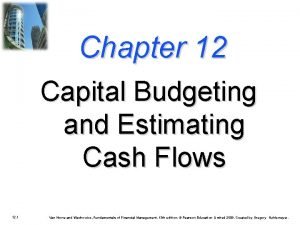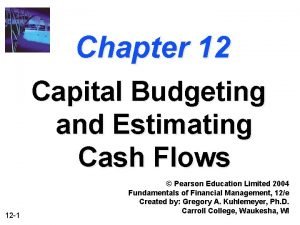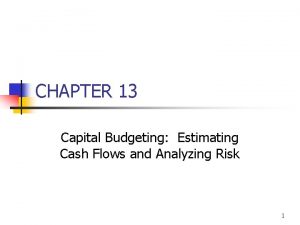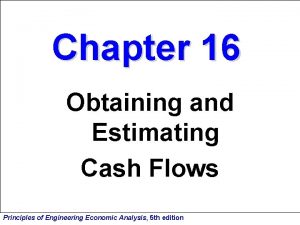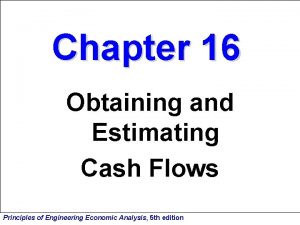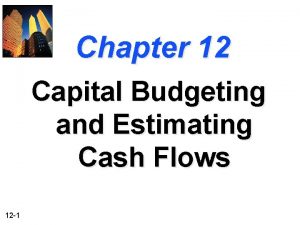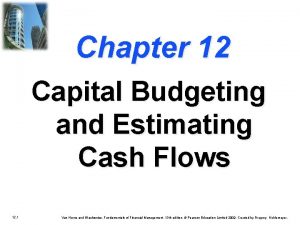CHAPTER 6 ESTIMATING RELEVANT CASH FLOWS Chapter outline



















- Slides: 19

CHAPTER 6 ESTIMATING RELEVANT CASH FLOWS

Chapter outline • • • Introduction Difference between profit and cash flow Estimating relevant cash flows Components of project cash flows Calculation of the initial investment Calculation of the operating cash flows Calculation of the terminal cash flow Capital gains tax Conclusion

Learning outcomes By the end of this chapter, you should be able to: • justify why cash flows, not profits, are relevant to capital budgeting decisions • explain how tax considerations and depreciation for tax purposes affect capital budgeting decisions • calculate the initial investment associated with a proposed capital expenditure • determine the relevant operating cash flows associated with a proposed capital expenditure • calculate the terminal cash flow associated with a proposed capital expenditure.

Introduction • Investing large sums of money in a project with expectation of generating future cash flows that will be sufficient to warrant the initial investment § Before managers acquire new capital assets, they need to be sure investment will yield positive NPV • Process of evaluating projects: main focus of capital budgeting • Need to focus on calculating cash flows § Required to evaluate capital investments to determine if they contribute to shareholder wealth maximisation

Difference between profit and cash flows • When investigating financial feasibility: § Focus is placed only on cash flow of project, and not profit § Reason: profit represents accounting item calculated based on accounting guidelines § Profit does not necessarily represent cash flow • Another distinction between profit and cash flow: § Profits calculated for certain period of time § Cash flows determined on specific point in time (when cash is physically received or spent)

Estimating relevant cash flows • Relevant cash flows § Cash flow that leads to change in business’ overall future cash flows, direct consequence of accepting a project § Incremental cash flows • Evaluation of expansion activities § Focus placed on cash flows associated with new project • Evaluation of replacement activities § Comparison between current cash flow, and cash flow after replacement took place

Estimating relevant cash flows • Sunk costs § Unrecoverable past costs § Excluded when determining a project’s incremental contribution to overall cash flow of the business • Opportunity costs § Value of most valuable alternative given up if investment is undertaken § Should be included as part of relevant cost • Finance costs § Already included in company’s cost of capital, excluded • Inflation and tax § After-tax cash flows § Company tax, capital gains tax

Components of cash flows • Initial investment • Operating cash flow • Terminal cash flow

Calculating the initial investment • Total up-front costs § § Cost of investment Shipping and installation costs Training costs Any change in net working capital • Calculated on an after-tax basis • Distinction between replacement and expansion projects

Initial investment for an expansion project • Relevant cash flow determined by considering additional cash flows that will result from new project

Initial investment for a replacement project • Not sufficient to focus only on cash flows associated with new assets • Also need to consider what effect removal of existing asset has on company’s cash flows

Example 6. 4

Calculating the operating cash flows • After initial investment is made, series of cash flows usually generated over project lifetime • Major objective is to identify projects in which cash flows will be generated to justify initial investment • Capital investment represents investment in fixed assets for operating activities • Utilising asset will generate cash flow

Calculating the operating cash flows • Operating cash flows for expansion project • Operating cash flows for replacement project § Incremental after-tax cash flows shows replacement asset cuts costs or provides higher income

Calculating the terminal cash flow • Cash flows that relate only to final year of project lifetime • Three common categories: § Estimated salvage value § Shut-down costs § Recovery of the investment in net working capital provided for at beginning of project lifetime as part of initial investment

Capital gains tax • Provision for capital gains tax not necessary when assets are sold at prices less than their original cost prices • Is possible, however, that an asset can be sold at price in excess of not only its book value, but also in excess of its original purchase price • In such a situation, transaction will also be exposed to capital gains tax

Example 6. 8

Conclusion • The focus should be placed on cash flows, and not profit, when capital projects are appraised. • Sunk costs and additional financial costs should not be included when determining a project’s relevant cash flows. • In contrast, opportunity costs, inflation and taxes should be included when estimating a project’s relevant cash flows.

Conclusion (cont. ) • Although the procedure differs slightly when estimating cash flows for an expansion project and a replacement project, projects consists of three types of cash flows, namely an initial investment, operating cash flows during the life of the project and a terminal cash flow. • In those cases where assets are sold for more than their original cost price, the resulting capital gain will be taxable.
 Relevant cash flows definition
Relevant cash flows definition Relevant cash flows
Relevant cash flows Direct labor budget formula
Direct labor budget formula Prepaid expense in cash flow statement
Prepaid expense in cash flow statement How to find change in working capital
How to find change in working capital Chapter 13 statement of cash flows
Chapter 13 statement of cash flows Chapter 23 statement of cash flows
Chapter 23 statement of cash flows Chapter 13 statement of cash flows
Chapter 13 statement of cash flows Chapter 13 statement of cash flows
Chapter 13 statement of cash flows Chapter 23 statement of cash flows
Chapter 23 statement of cash flows Chapter 23 statement of cash flows
Chapter 23 statement of cash flows Incremental cash flow analysis
Incremental cash flow analysis Pv of cash flows formula
Pv of cash flows formula Incremental cash flows
Incremental cash flows Payback equation
Payback equation Cash flow indirect method
Cash flow indirect method How to calculate incremental cash flows
How to calculate incremental cash flows Incremental cash flow
Incremental cash flow Incremental cash flows definition
Incremental cash flows definition Examples of incremental cash flows
Examples of incremental cash flows
